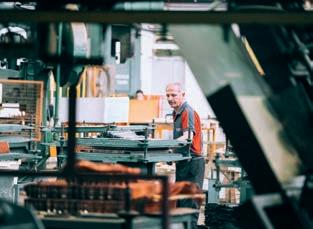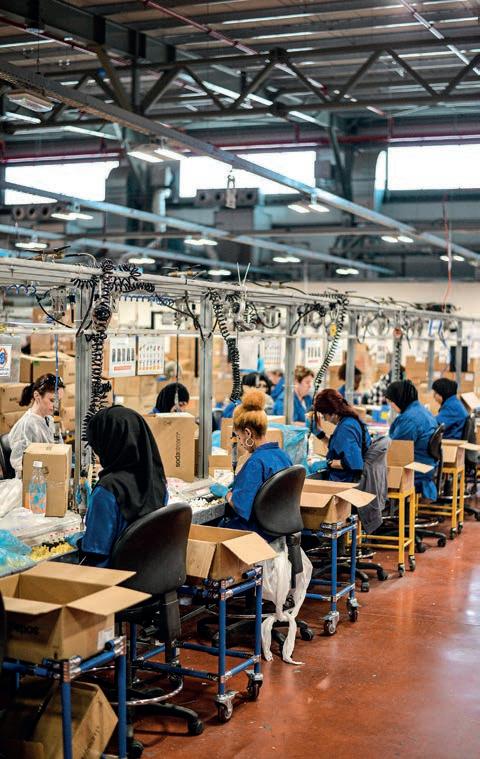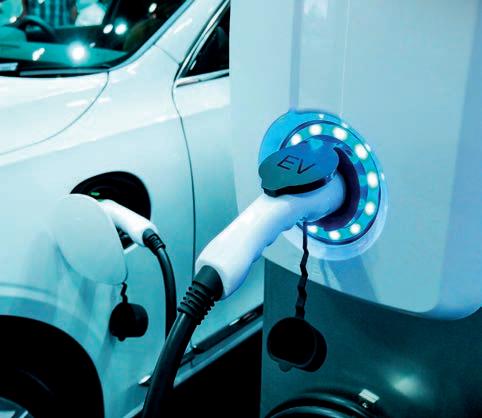
4 minute read
Key Issue
from ECN March 2021
LEVERAGING CCTV TO PROTECT THE BOTTOM LINE
David Armitage, managing director of security firm, Centurion, explores how CCTV is capable of protecting the bottom line.
Advertisement
Intuitive camera systems can be a powerful system for boosting profits, protecting the bottom line and preventing injury claims CCTV, in its most basic form, is traditionally known as a tool for capturing thieves in action. And whilst it does deter and identify criminals, it is actually a formidable tool in far more ways than meets the eye – particularly within sectors such as manufacturing and distribution.
In fact, intuitive camera systems – when used properly – can be a powerful system for boosting profits, protecting the bottom line and preventing injury claims. And with the additional threat of COVID-19, it can also be used to alert staff to potential carriers of the virus.
It is widely known that British companies lose thousands of pounds per year due to external and internal theft. No one knows for certain an exact figure of how much firms are losing each year through pilfering – but one estimate has put it at a staggering figure of £248m.
That’s why Centurion has a disproportionately large number of clients within premises over 50,000ft2 – the company has installed CCTV and access systems in hundreds of factories, distribution centres and facilities in the North of the UK. Centurion has a deep understanding of the challenges and the opportunities that arise, from the installation of monitoring technology.
Using CCTV to reduce theft
Firstly, and most obviously, is the loss of stock. Shop floors and stores are a common target for theft, but with the installation of cameras, the threat of robbery is often dramatically reduced.
This leads to a reduction in pilfering by staff, who take home equipment such as drill bits, cable ties and scrap metal, to name a few. With the installation of well-placed CCTV, the opportunity for such theft is dramatically cut.
CCTV can also be used to identify external thieves before they enter the building. License plate recognition (LPR) cameras can scan number plates on entry to a car park and alert staff to known shoplifters arriving, so that a security guard can screen them.
CCTV for health and safety measures
Health and safety compliance is another common reason for CCTV installation. The ability to watch accidents by reviewing recorded incidents can be the difference between having a large insurance claim or none at all. It is often all-too-easy for self-inflicted slips or trips to turn into accident claims, but with HD, 24-hour camera monitoring, retailers can deny fault, and limit claims against them. On the flipside, it can also help to pinpoint areas for improvement in health and safety assessments.
CCTV heat mapping retail analysis
CCTV heat mapping is where the technology starts to come into its own. Able to identify traffic flow, CCTV systems with analytics can provide intuitive reporting on shop floor directional paths, processes and inefficiencies.
Without adequate and reliable process monitoring, an unexpected process occurrence cannot be controlled, or eliminated.
Similarly, object detection allows a camera to alert management when problem occurs, like equipment failure. Cameras can detect when a person or vehicle crosses a virtual line and sound an alarm. They can also sound when a shipment comes in or out by watching for trucks on the loading dock.
This type of functionality means that better, well-informed business decisions can be made. Using this information, directors are able to ascertain optimum staffing levels.
Process control
Another opportunity for boosting profits lies in increased efficiencies. Process control plays an important role in how manufacturing procedures can be improved and decentivises staff to work at a slowed pace.
Staff safety and wellbeing should always take priority, and scheduled breaks are vital, but it is commonly known that unmonitored night shift work is less productive than day shift work, when managers are not present. Productivity can be dramatically improved by the installation of cameras, reducing costs and boosting profits.

COVID-19 CCTV cameras
With the introduction of temperaturemonitoring cameras, some CCTV systems are now also able to quickly identify persons at risk of carrying COVID-19, helping staff to decide whether to allow them entry into the facilities. This knowledge has the potential to safeguard staff and protect the bottom line, as fewer employees will require self-isolation or sick leave.
Processes aren’t affected by this process, as each person who enters doesn’t require individual testing, and there’s no lag in entry, as the system can test up to 30 people simultaneously. Only if someone is identified as a risk, will delays occur.
Upon alert, staff can then decide if they’d like to conduct a further level of testing, with the introduction of a handheld temperature monitor, carried out by a member of staff from a safe distance. Touchless access and exit buttons are also available, reducing the threat of infection spreading even further.
These measures, which would have seemed unthinkable a year ago, now seem inevitable for large facilities.
For those who take the pandemic risk seriously, and want to be viewed as doing so, the decision to invest in such technology is almost an easy one.
When it comes to ‘traditional’ CCTV, the return on investment is often recouped in a few short months, but when it comes to COVID-19, the payback is even shorter, particularly considering the goodwill gained from stakeholders.
And for those who realise the benefits of a powerful CCTV system, but don’t want to outlay the investment, leasing options are available.
Centurion has installed CCTV and access systems in hundreds of factories










